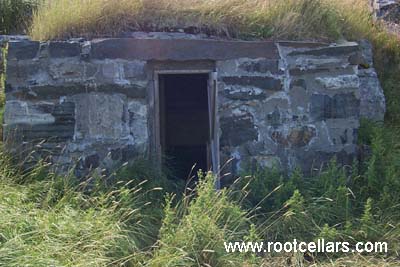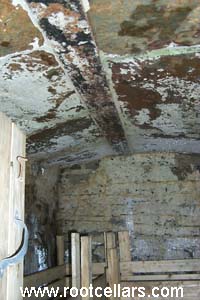Home ||| Cellar FAQs ||| Cellar Folklore ||| Root Cellar Tour
What is a root cellar?
How old are Elliston's root cellars?
How were root cellars constructed?
What materials were used to build root cellars?
Were all the root cellars built using the same materials?
What tools were used?
Where did root cellars come from?
When were root cellars constructed?
Why use a root cellar?
What else did people use root cellars for?
When was a reference to Elliston root cellars first made?
Were root cellars considered oddities?
A root cellar can be described as a structure that was built in the days before electricity in order to keep vegetables from freezing in the winter months and to keep it contents cool during the warm summer months. Elliston first received electrical power in the main part of town in the 1920's, but the Maberly area did not have this service until the 1960's. However, even after people began using electric refrigerators, the root cellars were still used by some families.
How old are Elliston's root cellars?
The oldest surviving cellars date back to 1839, being originally owned/built by George Porter, a second by Israel Baker, and a third by Abel Crewe. A root cellar that was built around 1839, and located in the Maberly area (displayed below), is still in use today, and is in quite good condition. The newer root cellars are at least 60 or so years old, having been built in the 1950's.
How were root cellars constructed?
There were three ways in which a cellar could be built: by digging a hole in the ground, from the ground up or by digging out of a hill. The most noticeable type of root cellar that can be seen in Elliston is the kind that is built into a hill. To view various examples check out the Root Cellar Tour.

Type I: Hatch Cellar
The first way was by digging down into the ground. Usually this involved a cellar underground with a shed built over it. This type of cellar was convenient in that you could go into it by using a trap door in the shed that was built over the root cellar.
Type II: Ground Up Cellar
Many people built a cellar this way mainly because they didn't have a hill on their land, and they didn't want a cellar/shed type of root cellar. The cellar was mainly built up from the ground using what seems like a wooden structure. Rock was then used, with sods put over the top and sides of the root cellar. Some of the advantages of building this type of cellar were that it was easier to excavate, and it was easier and cheaper to build.
Type III: Hill Side Cellar
This type began by digging a hole out of the side of a hill. The cellar was ordinarily a cave hollowed into the side of a hill with outer walls of rock. The roof was a wooden framework covered with sods. The main advantage to building the root cellar in this way was that water that should seep would run out the door.
What materials were used to build root cellars?
At the time most root cellars were built many modern materials were not available. The older cellars were built using rocks, wood, mortar (cement), and sods. The newer ones, from the 1920's on, are mostly made out of concrete with sods put on top. The doors were mainly of wooden construction.
Were all the root cellars built using the same materials?
For the most part they were but not always. For example, the root cellar displayed below was built in 1879 by Tom Porter. If you look inside, you can see a steel beam that is put into the roof of the cellar. The steel beam is from the shipwreck of the "Eric." This shipwreck occurred near Flowers Cove (a cove located near Maberly) in the 1870s. It took two days to bring the beam from Maberly to Elliston with a horse and cart.


What tools were used?
Most of the root cellars located in Elliston were built in a time where most of today's modern tools were not available. The men did not have power saws or cement mixers. The tools that they did have were basic ones such as picks, shovels and crowbars. Wheelbarrows were used to move the rocks and sods. Other tools used by a few of the men were mauls (7 to 10 pounds), block and tackle, and wooden levels.
Where did root cellars come from?
No one exactly knows where the idea of building root cellars originated. The first settlers to Elliston (Bird Island Cove) had ties that can be traced back to England, and what was once known as the "West Country." It is also believed that a small number of settlers to this area came from Ireland. Although it can be assumed that the technology of the root cellar was introduced into this area by these settlers, one cannot say with absolute certainty that this was the case.
When were root cellars constructed?
Short answer = When time permitted. The men would only have time to build a root cellar when they weren't busy fishing or cutting wood. Most fishing was done from late spring until late in the fall, and most of the wood was cut during the fall and winter. So the early spring was really the only opportunity to build a root cellar. It would take about a month for one man to build a cellar. Only one to two weeks if four or five men worked on it. Older men recommended that the root cellar doors, if possible, should face the east. The reason for this is that easterly winds were believed to be generally frost free.
Why use a root cellar?
There were two main reasons why the citizens of this community used root cellars in the past: to keep food supplies from freezing during the winter months and to keep food supplies cool during the summer months. Typically, families would put a variety of vegetables in the root cellar in the fall of the year, after the harvesting of the vegetable gardens had been completed. The main vegetables stored in the root cellar consisted of potatoes, turnip, and carrot. Although some people did store cabbage in the root cellar, it would appear that most did not as cabbage had a tendency to rot if not pickled first. Other food supplies placed in the root cellar over the winter months included beets, preserves/jams, salt meat, salt turbot, and salt herring.
Food supplies were kept in the root cellar in the summer months to avoid spoilage. Water, bread, butter, milk, and cream were stored in the typical root cellar so that these items could be used more than once by the family. In addition, items such as salads, fresh meat, and jam pies were kept in the root cellar early in the day, so that they could keep cool until they were needed for supper.
Another important reason to use a root cellar was the unavailability of electric refrigeration to the community in the 1800's and early 1900's. The root cellar was essential to the people living in Elliston from the time of settlement up until the time when electricity first came to the community. Elliston first received electrical power in the main part of town in the 1920's and the Maberly area in the 1960's.
What else did people use root cellars for?
A secondary use for the root cellar seems to be as a place in which to store alcoholic beverages. The men of Elliston apparently used the root cellar as a place in which to keep their homemade wine and beer. Anderson Chaulk once stated that his father used to brew his blueberry wine and put it in the cellar until Christmas. By then, it would be perfect. Indeed, many local men made reference to using the root cellar as an ideal place in which to brew their alcoholic spirits.
When was a reference to Elliston root cellars first made?
The first reference found in print about Elliston’s root cellars was in 1846 with a reference that “. . . potatoes . . . are generally sown in the month of May and the beginning of June, and are dug up and deposited in the cellars, from the winter frost, in October.” While the number of cellars during this early time is unknown, this does suggest that many more once existed in this area.
Were root cellars considered oddities?
Not at all. Root cellars were a part of life in this area. Up until the mid-1900's it was rather difficult to purchase vegetables in this area. This meant that most, if not all, citizens of this community had a vegetable garden. One can imagine men and women digging up their gardens in the fall of the year, and with help from their children, putting the vegetables in a root cellar that was probably located not too far from where they resided. Root cellars were not considered to be oddities, but quite the opposite, were essential to the subsistence of this and many other areas of this province.
